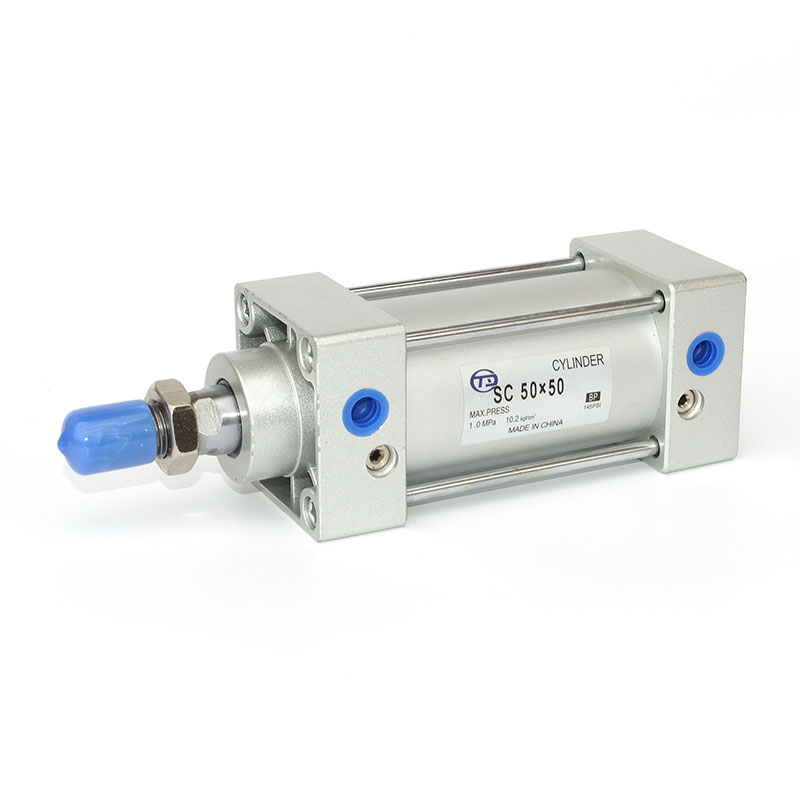Pneumatic cylinder actuator, also called
air cylinder actuator is a kind of component which uses compressed air as power and drives the mechanism to move in straight line, swing and rotation.
Classification of Cylinders
1. Single acting cylinder:
Single-acting cylinder piston only provides air on one side. Pneumatic pressure pushes the piston to produce thrust and return by spring or self-weight.
2. Dual acting cylinder:
Dual-acting cylinder is made up of cylinder piston with air pressure on both sides to achieve forward or backward action.
Buffer of Pneumatic Cylinder Actuator
However, there is also a problem with the pneumatic cylinder actuator. If the cushion device is not used, when the piston moves to the end, especially the pneumatic cylinder actuator with long travel and fast speed, the kinetic energy of the piston hitting the end cap will be very large, which can easily damage parts and shorten the life of the cylinder.
What's more, the noise caused by the impact is quite lethal. If the noise of a cylinder without a buffer is 70 dB, the noise of the whole factory will be 140 dB, just like being on the runway of a jet plane for a long time. This has reached the limit of human intolerance and suffering.
How to solve these problems? Our designer designed the cushion for the air cylinder.
1. Hydraulic Buffer
The first and simplest method of cylinder cushioning is to install a hydraulic cushion at the front end of the cylinder.
Through the unique design of damping holes and using mineral oil as medium, the transition from high-speed light load to low-speed heavy load can be realized smoothly.
Features: From small energy to large capacity, there is no need to adjust the wide range, can achieve the best energy absorption.
2. Rubber Buffer
In order to install more compactly in the factory, designers have come up with a second method: rubber cushioning. (Cushion pads are installed at both ends of the piston rod)
Attention:
1) The cushioning capacity is fixed and immutable, and the cushioning capacity is small. It is mostly used in small cylinders to prevent noise.
2) Attention should be paid to the phenomena of deformation and exfoliation caused by rubber aging.
3. Air cushion
The third method: air cushioning. (When the piston moves, the buffer sleeve and seal ring work together to form a closed chamber/buffer chamber on one side to realize the buffer.)
The gas in the buffer chamber can only be discharged through the buffer valve. When the opening of the buffer valve is very small, the pressure in the chamber rises rapidly, which produces a reaction force on the piston, thus slowing down the piston until it stops.
Attention:
1) By adjusting the opening of the buffer valve, the buffer capacity can be adjusted. The smaller the opening, the greater the buffer force.
2) Buffer is realized by using the back pressure of the cylinder. Cylinder back pressure is low. Buffering capacity will also be reduced. In use, attention should be paid to the control methods of load rate and cylinder speed.
Magnetic switch
Speaking of this, we know how the cylinder moves smoothly. But everything has rules, and so does the movement of cylinders. Are they all in place? Are there any crossings? Who should supervise this?
Magnetic switch - It is a feedback signal to judge whether the cylinder is in place, and control the corresponding solenoid valve to complete the switching action.
Principle: With the piston moving magnetic ring close to or away from the switch, the current in the switch is magnetized to attract or disconnect each other, sending out electrical signals.
Features: There is no need to install computer-controlled valve and its mounting frame at both ends of cylinder stroke, and no need to install bumper at piston rod end. Therefore, it is easy to use, compact in structure, high reliability, long service life, low cost, fast response time of switch, and has been widely used.
Lubrication of Pneumatic Cylinder Actuator
In addition, we also want to talk about lubrication, the purpose of which is to reduce the damage of cylinder motion to the cylinder itself and prolong the service life of the air cylinder.
1. Oil lubrication:
Oil mist is used to transport lubricant into compressed air to the cylinder.
2. Non-oil lubrication:
Only use built-in grease, no need to use oil mist for oil supply; avoid contamination of food and drug packaging by oil particles during transportation, influence on the properties of some industrial chemical pigments, or influence on the accuracy of testing instruments.
At present, most manufacturers have fully realized the non-feed cylinder.
Attention:
Once oil lubrication is used, it needs to be used continuously. Once it's out of service, its life will drop sharply.



